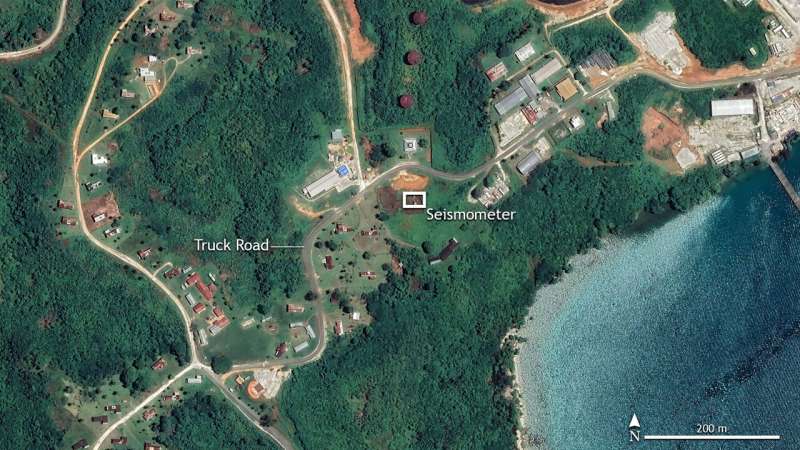March 9, 2024 report
This article has been reviewed according to Science X's editorial process and policies. Editors have highlighted the following attributes while ensuring the content's credibility:
fact-checked
trusted source
proofread
Saturday Citations: New hope for rumbly guts; 'alien' signal turns out to be terrestrial and boring. Plus: A cool video

I've seen things you people wouldn't believe. Rodents eating herbal remedies. I watched a truck mistaken for an alien message. All those moments will be lost in time, like the Upper West Side under land subsidence.
Tummy better
Researchers in Brazil report that a nanoemulsion of curcumin, the bright yellow chemical compound in turmeric, modulated the gut microbiota of mice with intestinal inflammation and made their tummies better.
Curcumin has been cited for possible anti-inflammatory properties and the alleviation of autoimmune and anxiety disorders, but research is scarce, and global demand for new, inexpensive approaches is high. Unfortunately, curcumin also has low bioavailability when taken orally.
One approach is adding compounds from black pepper, which greatly increases curcumin uptake, but in this study, the researchers created an emulsion of curcumin nanoparticles and administered it to mice with rumbly guts, evaluating its stability, morphology, and physicochemical properties. Following treatment, the mice had an increased presence of beneficial microbiota, including good old Lactobacillus.
The researchers hope eventually to produce an inexpensive treatment for conditions like inflammatory bowel disease.
Headline commendable
The week's best headline, provided by Johns Hopkins University, crystallizes all the text in the article into a microscopic lattice of geometric purity. In the story, "Interstellar signal linked to aliens was actually just a truck," a Johns Hopkins researcher clarifies that sound waves believed to be caused by a 2014 meteor fireball north of Papua New Guinea were just the vibrations of a truck.
You didn't even need me to write that; it was already in the headline. I am a human redundancy; I'll show myself out. "The findings raise doubts that materials pulled last year from the ocean are alien materials from that meteor, as was widely reported," according to the article.
As evidence, planetary seismologist Benjamin Fernando cites changes in the direction of the sound waves over time that corresponded exactly with a road running past the seismometer. "It's really difficult to take a signal and confirm it is not from something. But what we can do is show that there are lots of signals like this and show they have all the characteristics we'd expect from a truck and none of the characteristics we'd expect from a meteor," he says.
Geohazard modeled
New Yorkers who feel like the horizon line is higher than it used to be are probably unusually perceptive because that would be pretty difficult to eyeball, but they're not wrong. Land subsidence is impacting coastal cities around the world as subsurface material disappears and natural aquifers are depleted.
Sinking land damages infrastructure and water supplies, jeopardizing human lives and livability on coasts. Yes, we already have a lot on our plate with sea ice loss and undulating atmospheric jets and whatnot. But researchers in Colorado used deep learning artificial intelligence to make the first predictions of land subsidence at a global scale.
They conclude that more than 6.3 million square kilometers of Earth's surface are susceptible to significant subsidence; 231,000 square kilometers of susceptible regions consist of urban areas collectively inhabited by around 2 billion people. The model also determined that the main predictor of subsidence is groundwater abstraction; areas like New York City are also sinking because buildings are heavy.
The researchers recommend phasing out groundwater extraction in favor of sources like seawater desalination and treating wastewater.
This video is awesome
Red supergiant Betelgeuse is an exciting astronomy target due to its frequent variations in brightness and recently, astronomers have proposed that it is spinning faster than previously believed. However, researchers at the Max Planck Institute for Astrophysics are calling that assumption into question, proposing instead that the boiling surface of Betelgeuse can be mistaken for rotation (video is on the linked page.)
Using interferometry data from the Atacama Large Millimeter/submillimeter Array, they discovered what they describe as a dipolar radial velocity map on the outer surface of Betelgeuse, the visual effect of which is that half of the surface appears to be approaching us as the other half recedes.
But this is an illusion, according to the researchers, who say instead that the changes in apparent brightness are caused by the violently boiling surface of the star. Using the ALMA data, they made a video, which is the whole point of this paragraph and which I am not embedding here, but click through and check it out. This thing could be a Doom enemy and it would definitely get a cutscene when it entered the arena.
© 2024 Science X Network




















